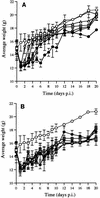Famciclovir and valaciclovir differ in the prevention of herpes simplex virus type 1 latency in mice: a quantitative study
- PMID: 9660982
- PMCID: PMC105644
- DOI: 10.1128/AAC.42.7.1555
Famciclovir and valaciclovir differ in the prevention of herpes simplex virus type 1 latency in mice: a quantitative study
Abstract
Famciclovir (FCV) and valaciclovir (VACV) have previously been shown to be potent inhibitors of herpes simplex virus type 1 (HSV-1) in a murine cutaneous model. In the present study, mice were inoculated in the skin of the left ear pinna with herpes simplex virus (HSV) type 1. Antiviral therapy was started on different days postinoculation (p.i.), terminating at the end of day 10 p.i. The compounds were administered twice daily by oral gavage at 50 mg/kg of body weight/dose. Mice were sampled on day 5 p.i., during the acute phase of the infection, and the titers of infectious virus in the target tissues (ear, brain stem, and trigeminal ganglia) were determined. At 2 to 3 months p.i., the ipsilateral and contralateral trigeminal and cervical dorsal root ganglia were explanted, and four different methods were used to detect latent HSV. The methods were (i) conventional explant culture for 5 days followed by homogenization, (ii) long-term culture (up to 73 days) of whole ganglia, followed by homogenization, (iii) dissociation by enzymatic disaggregation and an infectious center assay, and (iv) in situ hybridization to detect latency-associated transcripts (LATs). The conventional explant culture method was the least sensitive method, while in situ staining for LAT was the most sensitive, and all mice, including those treated from early times with FCV, were shown to be latently infected. Significantly less latent virus was detected by all four methods, however, in ganglia obtained from mice that had been treated with FCV in comparison with the amount detected in ganglia from mice that had been treated with VACV. However, in no case was latency completely eliminated.
Figures


References
-
- Arthur J, Efstathiou S, Simmons A. Intranuclear foci containing low abundance herpes simplex virus latency-associated transcripts visualized by non-isotopic in situ hybridization. J Gen Virol. 1993;74:1363–1370. - PubMed
-
- Bacon T H, Howard B A. Further characterization of the potent and prolonged inhibition of herpes simplex virus replication in human cell lines by penciclovir. Antivir Chem Chemother. 1996;7:128–137.
-
- Blyth W A, Harbour D A, Hill T J. Effect of acyclovir on recurrence of herpes simplex skin lesions in mice. J Gen Virol. 1980;48:417–419. - PubMed
MeSH terms
Substances
LinkOut - more resources
Full Text Sources
Medical
Research Materials

